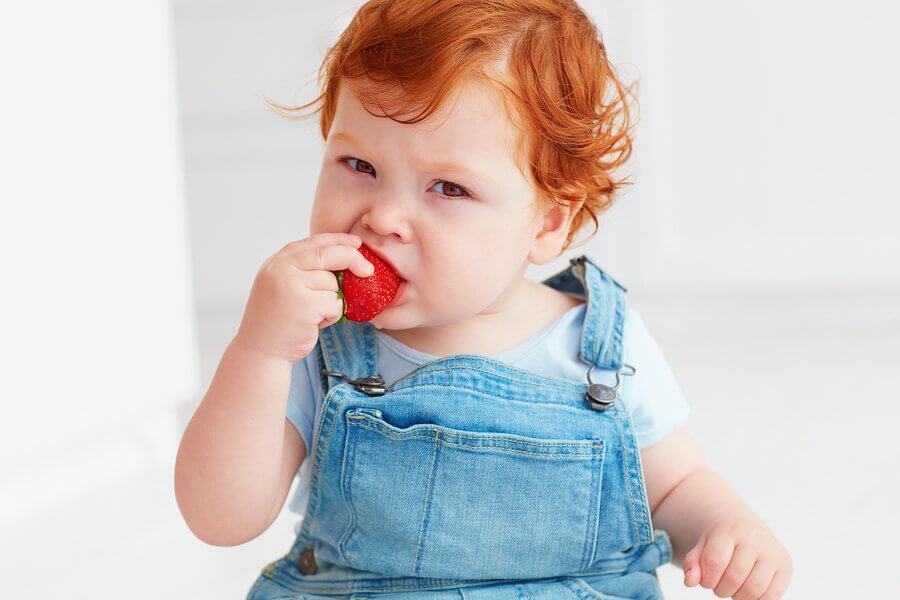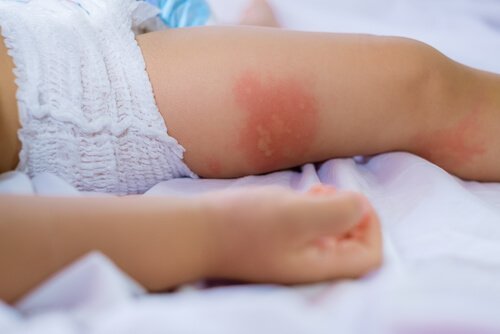Common Food Allergies in Babies

Common food allergies in babies are linked to their immune systems’ reactions. They happen because they reject substances present in certain foods. Next, we’ll take a look at this condition and its symptoms.
Food intolerances are a little different because the metabolic system intervenes. However, in the case of food allergies, the body’s defenses come into play. They can have many different symptoms, ranging from mild to severe.
Studies show that most food allergies have a direct relationship with genetics. However, many others appear when a child tries a new food and his body can’t process it. At least 10% of children have some kind of food allergy.
Common food allergies in babies
To know whether or not your baby has a food allergy, you’ll need to do more than watch your child’s symptoms at home. Ideally, your child will do allergy tests. That way, they can have a proper diagnosis with correct treatment.
Products linked to common food allergies in babies
There are many different foods that babies can be allergic to. Their appearance also depends on how soon these food products are introduced to the baby’s diet. Some of the most prominent are:
- Cow’s milk proteins
- Wheat
- Eggs
- Strawberries
- Peaches
- Kiwi
- Gluten
- Peanut butter
- Soy
- Peanuts
- Nuts
- Seafood, including fish and shellfish

Recommendations for introducing new foods
Based on what we know about foods that cause allergies, you need to keep some things in mind when introducing them.
Of course, the idea isn’t to deprive children of these foods without any reason. You don’t want to take them away if they don’t cause adverse effects.
In addition, taking foods away too soon could cause nutrient deficiencies – for example, the proteins present in cow’s milk.
To avoid making mistakes or making your child’s diet too extreme, we recommend:
- Breastfeed the baby at the same time that you introduce a new food from the list.
- Only introduce one new food from the list at a time. Then, wait 5 days to observe how your child reacts to the new food. This is because atopic dermatitis, one of the later reactions, can happen several days later.
- Avoid introducing new foods before the child is 6 months old.
- Once you’ve introduced them, add them regularly to the diet. This is of course if there weren’t any reactions.
“Studies show that most food allergies have a direct relationship with genetics. However, many others appear when a child tries a new food and his body can’t process it.”
Symptoms of common food allergies
When faced with an allergy attack, children usually show the following signs:
- Trouble swallowing
- Inflammation in the mouth, tongue or face in general
- Reddish spots on any part of the body
- Asthma
- Atopic dermatitis
- Nausea and vomiting
- Urticaria
- Pruritus
- Erythema
- Nasal congestion
- Bronchospasm crisis
- Anaphylaxis. In the most extreme cases, blood pressure may decrease, causing the child to faint. If this happens to your baby, call an ambulance immediately.
Onset of symptoms
The symptoms usually appear in three lapses. These are called immediate, delayed and late. The immediate ones appear within 30 minutes of ingesting the food. They’re usually urticaria, asthma, difficulty swallowing, reddish spots and anaphylaxis.
Meanwhile, the delayed symptoms appear two hours after giving the baby the food. These are usually nasal congestion, facial swelling, diarrhea and vomiting.

Finally, late symptoms may appear up to five days after the child tries the food. The most common symptom is atopic dermatitis.
As a final recommendation, if you notice any unfavorable reaction, don’t hesitate to ask for a consultation. The pediatrician will then evaluate the effects of the food.
If the symptoms are alarming, take the child immediately to the emergency room or call an ambulance. Remember, the baby’s airways can close in only a few minutes from allergic reactions.
All cited sources were thoroughly reviewed by our team to ensure their quality, reliability, currency, and validity. The bibliography of this article was considered reliable and of academic or scientific accuracy.
- Deschildre A., Lejeune S., How to cope with food allergy symptoms? Curr Opin Allergy Clin Immunol, 2018. 18 (3): 234-242.
- Cartledge N., Chan S., Atopic dermatitis and food allergy: a paediatric approach. Curr Pediatr Rev, 2018. 14 (3): 171-179.